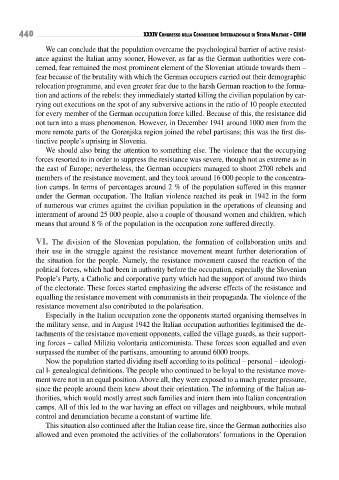Page 440 - Conflitti Militari e Popolazioni Civili - Tomo I
P. 440
440 XXXIV Congresso della CommIssIone InternazIonale dI storIa mIlItare • CIHm
We can conclude that the population overcame the psychological barrier of active resist-
ance against the Italian army sooner, However, as far as the German authorities were con-
cerned, fear remained the most prominent element of the Slovenian attitude towards them –
fear because of the brutality with which the German occupiers carried out their demographic
relocation programme, and even greater fear due to the harsh German reaction to the forma-
tion and actions of the rebels: they immediately started killing the civilian population by car-
rying out executions on the spot of any subversive actions in the ratio of 10 people executed
for every member of the German occupation force killed. Because of this, the resistance did
not turn into a mass phenomenon. However, in December 1941 around 1000 men from the
more remote parts of the Gorenjska region joined the rebel partisans; this was the first dis-
tinctive people’s uprising in Slovenia.
We should also bring the attention to something else. The violence that the occupying
forces resorted to in order to suppress the resistance was severe, though not as extreme as in
the east of Europe; nevertheless, the German occupiers managed to shoot 2700 rebels and
members of the resistance movement, and they took around 16 000 people to the concentra-
tion camps. In terms of percentages around 2 % of the population suffered in this manner
under the German occupation. The Italian violence reached its peak in 1942 in the form
of numerous war crimes against the civilian population in the operations of cleansing and
internment of around 25 000 people, also a couple of thousand women and children, which
means that around 8 % of the population in the occupation zone suffered directly.
Vi. The division of the Slovenian population, the formation of collaboration units and
their use in the struggle against the resistance movement meant further deterioration of
the situation for the people. Namely, the resistance movement caused the reaction of the
political forces, which had been in authority before the occupation, especially the Slovenian
People’s Party, a Catholic and corporative party which had the support of around two thirds
of the electorate. These forces started emphasizing the adverse effects of the resistance and
equalling the resistance movement with communists in their propaganda. The violence of the
resistance movement also contributed to the polarisation.
Especially in the Italian occupation zone the opponents started organising themselves in
the military sense, and in August 1942 the Italian occupation authorities legitimised the de-
tachments of the resistance movement opponents, called the village guards, as their support-
ing forces – called Milizia volontaria anticomunista. These forces soon equalled and even
surpassed the number of the partisans, amounting to around 6000 troops.
Now the population started dividing itself according to its political – personal – ideologi-
cal l- genealogical definitions. The people who continued to be loyal to the resistance move-
ment were not in an equal position. Above all, they were exposed to a much greater pressure,
since the people around them knew about their orientation. The informing of the Italian au-
thorities, which would mostly arrest such families and intern them into Italian concentration
camps. All of this led to the war having an effect on villages and neighbours, while mutual
control and denunciation became a constant of wartime life.
This situation also continued after the Italian cease fire, since the German authorities also
allowed and even promoted the activities of the collaborators’ formations in the Operation

